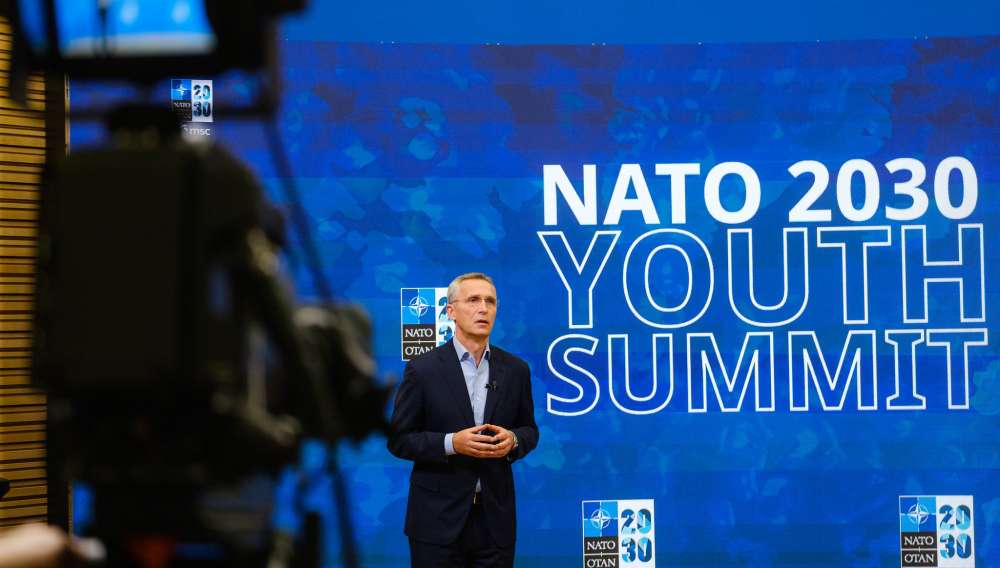The NATO 2030 Approach to Youth Participation: Nice Try, But Not Enough

As an organization born in the long shadow of World War II, NATO has already had to reinvent itself twice: after the end of the Cold War in the early 1990s and then again after the attacks on September 11, 2001. Today, a third such restructuring seems inevitable. This time, there is no single event to trigger debates about a change in NATO’s direction. The alliance rather faces a host of internal issues, such as disputes over burden-sharing or the rising tensions between Turkey and the rest of the alliance, which have led to a general – and growing – frustration among its members. In his four years in office, former US President Donald Trump worked hard to undermine his country’s commitment to NATO. Meanwhile, on the European side, things are not looking much better – just remember French President Emmanuel Macron’s declaration that NATO was “brain dead.”
When he first uttered this statement in November 2019, Macron’s words caused quite a stir – and bolted NATO leaders into action. Shortly after the remark, they tasked NATO Secretary-General Jens Stoltenberg with a reflection process to determine how the alliance should develop to guarantee “freedoms, values, and security for generations to come.” As a result, in 2020, Stoltenberg launched the NATO 2030 initiative and formed a group of ten experts – all between 40 and 73 years old – to advise him on this process.
The Success of NATO 2030 Depends on Young People
There are a number of reasons why NATO 2030 will not succeed without meaningful youth participation. Stoltenberg rightfully noted that “young people have the greatest stake in [NATO’s] future.” He seems to have understood that a reorientation driven exclusively by those who already hold power will not guarantee success in the long term. Young people’s fundamental right to be included is rooted in the fact that future-oriented decisions will heavily affect their lives. Stoltenberg’s remarks indicate that NATO recognizes that. Moreover, in more practical terms, long-term policies need not just one but a series of leaders from different generations who commit to and feel responsible for implementing the different steps. Multi-year change processes like the NATO 2030 initiative have the best chance of consistency and success when they are co-developed with as many stakeholders as possible – including those who are still young. Only if future leaders support the goals they will one day have to implement can long-term projects run coherently from the start. Finally, young people bring a perspective that is unmarred by the tunnel vision that inevitably comes with long careers. Since they look at issues from outside of the professional world, they are free to think in categories barring considerations of power and can avoid entrenched patterns of thinking that elevate any one discipline. As such, they may detect or emphasize different issues that are nevertheless crucial for NATO to be a viable alliance in the future.
Avoiding Tokenism Means Taking Young People Seriously
To deliver on his words and move the organization toward greater youth participation, Stoltenberg called a NATO 2030 Youth Summit in November 2020. He also appointed 14 NATO 2030 Young Leaders who will advise him on the NATO 2030 initiative. These are commendable steps in the right direction, but they also suffer from serious shortcomings.
For one, the NATO 2030 Young Leaders are already professionals. The group consists of chairs of parliamentary committees, founders of organizations, policy and research fellows, senior advisors, specialists, analysts, lawyers, and diplomats. They are already well into their career paths, leaders in their professional communities, and winning awards for their work. There is no reason why they would need an extra body rather than receiving seats in the ‘regular’ expert advisory group. In fact, the oldest of the Young Leaders (they are all between 25 and 35 years old) are only a couple of years younger than the youngest ‘regular’ experts.
Secondly, the NATO 2030 Youth Summit fell short of its central promise to empower youths and allow for their meaningful participation. With exceptions like Luisa Neubauer, one of the public faces of Germany’s Fridays for Future movement, most conference panelists did not even fall under NATO’s definition of ‘young’. The average age of the 900 invited attendees was 31 years – not too bad, but most likely also the result of self-selection: invitations were issued to hundreds of former young professionals, many of whom are already well above this age. During the summit itself, the attendees had only very limited opportunities to actually participate in the program – and none to interact with each other or the panelists. Instead of creating genuine inter-generational dialogue, the Youth Summit involved more talking by those who are always talking, and more listening on the side of those who are always listening.
Admittedly, the time horizon of the NATO 2030 vision is limited – it is a ten-year process. By the organization’s current definition of ‘youth’ – those who are younger than 35 – all of the NATO 2030 Young Leaders will have lost their ‘young’ status by the time 2030 rolls around. However, by then, new young leaders will have emerged – those who have just now entered their first jobs, are still studying at university or are even still in school. Taking youth participation and long-term thinking seriously means talking to this group today. The UN is a good example in this regard: their concept of youth includes those who are between 15 and 24 years old. Youth participation done right entails hearing the voices of the upcoming generation, not only the up-and-coming.
NATO Needs to Change Its Mindset and Inclusion Practices for 2030 and Beyond
There are a number of steps NATO should take to remedy these shortcomings and ensure more meaningful participation of future leaders. Apart from reforming youth engagement projects, and on a more fundamental level, this will require a greater willingness to adopt a different mindset: youth participation only works if young people and their viewpoints are taken seriously and treated like they deserve attention. NATO must make a conscious effort to avoid that the inclusion of young experts on security issues becomes a mere exercise in tokenism. No young person, no young leader and no one Luisa Neubauer can speak for their entire generation. Individual experts come with their individual perspectives and opinions: their age is just one aspect of this, even if it is a relevant one.
Although not truly ‘youth’ anymore, the NATO 2030 Young Leaders are an important improvement over only having a ‘regular’ expert advisory group. But there is also a danger that they will merely serve to boost the organization’s image at public events every couple of months, far away from all the action. So far, their specific mandate hasn’t been clarified. This offers an opportunity for the organization to ensure that the Young Leaders actually contribute to the strategic direction of the alliance. Their competence and experience should be recognized in their own right – and their opinions should be taken into account for every major decision that will shape the future of the alliance.
Whenever a broader ‘young generation’s angle’ is required over the course of the reorientation process, youth participation events can be helpful – if done right. Here, the main lessons from the Youth Summit should be to actively involve younger participants, including by opening up future fora to youths with varied backgrounds who are not yet professionals. In addition to large summits, regular events on a smaller scale, such as (virtual) lounges and roundtables, can enable discussions between people at different levels of expertise and foster a real exchange of arguments. These could also focus on specific issues that are of special relevance to the future of NATO, such as the alliance’s handling of an increasingly aggressive China or the implications of new technologies and developments in the realm of cyber warfare. The central ideas gathered via these formats should be summarized and brought to the attention of Secretary-General Stoltenberg as well as the respective heads of relevant departments at NATO. The first NATO policy hackathon is a commendable step in this direction.
By far the most important action, however, is for NATO to invest in a serious and systematic effort to include young contributors in all its regular processes – even beyond the 2030 reflection process. To do so, standing bodies like the NATO 2030 expert group should automatically reserve seats for younger candidates, meaning not only those under 35 but also for those who are younger than 25. Moreover, once the concrete outlines of the NATO 2030 vision take shape, the organization should include youths in the implementation process. This could be done by establishing additional civilian bodies such as regional working groups and policy committees or by developing low-level entry points for advisory groups within the military operational structure.
Establishing such channels for meaningful youth participation, as opposed to creating ‘kids’ tables’, will be crucial for the success of the NATO 2030 initiative’s central goal: to make NATO fit for the future – and to ensure that the alliance is able to guarantee “freedoms, values, and security for generations to come.”







